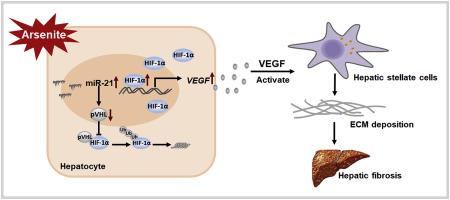Chemosphere ( IF 8.1 ) Pub Date : 2020-12-02 , DOI: 10.1016/j.chemosphere.2020.129177 Jing Sun 1 , Le Shi 2 , Tian Xiao 1 , Junchao Xue 1 , Junjie Li 1 , Peiwen Wang 1 , Lu Wu 1 , Xiangyu Dai 1 , Xinye Ni 3 , Qizhan Liu 1

|
Long-term exposure to arsenic, a widely distributed environmental toxicant, may result in damage to various organs, including the liver. Mice exposed chronically to arsenite developed hepatic damage, inflammation, and fibrosis, as well as increased levels of microRNA-21 (miR-21) and hypoxia-inducible factor (HIF)-1α. The levels of miR-21 and HIF-1α were also enhanced in primary hepatocytes and L-02 cells exposed to arsenite. The culture media from these cells induced the activation of hepatic stellate cells (HSCs), as demonstrated by up-regulation of the protein levels of α-smooth muscle actin (α-SMA) and collagen1A2 (COL1A2) and by increased activity in gel contractility assays. For L-02 cells, knockdown of miR-21 blocked the arsenite-induced up-regulation of HIF-1α and vascular endothelial growth factor (VEGF), which prevented the activation of LX-2 cells induced by medium from arsenite-exposed L-02 cells. However, these effects were reversed by down-regulation of von Hippel Lindau protein (pVHL). In arsenite-treated L-02 cells, miR-21 knockdown elevated the levels of ubiquitination and accelerated the degradation of HIF-1α via pVHL. In the livers of miR-21−/− mice exposed chronically to arsenite, there were less hepatic damage, lower fibrosis, lower levels of HIF-1α and VEGF, and higher levels of pVHL than for wild-type mice. In summary, we propose that miR-21, acting via the HIF-1α/VEGF signaling pathway, is involved in arsenite-induced hepatic fibrosis through mediating aberrant cross-talk of hepatocytes and HSCs. The findings provide evidence relating to the pathogenesis of hepatic fibrosis induced by exposure to arsenic.
中文翻译:

microRNA-21 通过 HIF-1α/VEGF 信号通路通过肝细胞和肝星状细胞的异常串扰参与亚砷酸盐诱导的肝纤维化
长期接触砷是一种广泛分布的环境毒物,可能会对包括肝脏在内的各种器官造成损害。长期暴露于亚砷酸盐的小鼠出现肝损伤、炎症和纤维化,以及 microRNA-21 (miR-21) 和缺氧诱导因子 (HIF)-1α 水平升高。在暴露于亚砷酸盐的原代肝细胞和 L-02 细胞中,miR-21 和 HIF-1α 的水平也有所提高。来自这些细胞的培养基诱导肝星状细胞 (HSC) 的活化,这可以通过上调 α-平滑肌肌动蛋白 (α-SMA) 和胶原蛋白1A2 (COL1A2) 的蛋白质水平以及凝胶收缩性的活性增加来证明化验。对于 L-02 细胞,miR-21 的敲低阻断了亚砷酸盐诱导的 HIF-1α 和血管内皮生长因子 (VEGF) 的上调,这阻止了由亚砷酸盐暴露的 L-02 细胞的培养基诱导的 LX-2 细胞的活化。然而,这些影响被 von Hippel Lindau 蛋白 (pVHL) 的下调所逆转。在亚砷酸盐处理的 L-02 细胞中,miR-21 敲低提高了泛素化水平并通过 pVHL 加速了 HIF-1α 的降解。在 miR-21 的肝脏中-/-与野生型小鼠相比,长期暴露于亚砷酸盐的小鼠肝损伤较少,纤维化程度较低,HIF-1α 和 VEGF 水平较低,pVHL 水平较高。总之,我们提出 miR-21 通过 HIF-1α/VEGF 信号通路发挥作用,通过介导肝细胞和 HSC 的异常串扰参与亚砷酸盐诱导的肝纤维化。这些发现提供了与砷暴露引起的肝纤维化发病机制有关的证据。











































 京公网安备 11010802027423号
京公网安备 11010802027423号